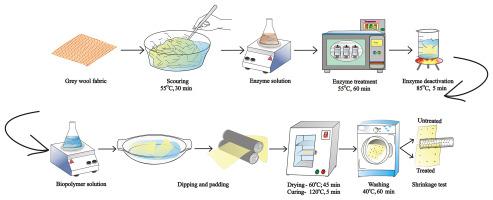Sustainable Materials and Technologies ( IF 8.6 ) Pub Date : 2021-05-28 , DOI: 10.1016/j.susmat.2021.e00298 Vinod Kadam , Sushma Rani , Seiko Jose , D.B. Shakyawar , N. Shanmugam

|
Shrinkage in the wool fabric is a practical limitation with reference to its dimensional stability, mechanical properties, and service life. The conventional processes of shrink resist finish to the wool fabric are not eco-friendly and they also deteriorate the fabric quality. This study reported an effective and eco-friendly treatment to impart shrink resistance to wool fabric. The sequential combination of enzymes followed by polysaccharide-based biopolymers obtained good shrink resistance and retained the original attributes of the wool fabric. The fabric was initially treated with laccase and protease enzymes separately. Following enzyme, fabrics were coated with three polysaccharide biopolymers (chitosan, wheat starch, and gum arabic) using the pad-dry-cure technique. The protease-chitosan combination showed the least area shrinkage (3.57%) as compared to the untreated fabric (16.37%). The effectiveness of the treatment was evaluated and validated on wool tops using the felt ball density test. The treated fabrics were characterized using FE-SEM, EDS, and FTIR. The tensile, frictional, and bending properties were analyzed against the untreated fabric. Except for friction, tensile and bending properties remain unaffected after the shrink resist treatment. The combination of treatment retained similar whiteness and also reduced yellowness of the wool fabric. A sustainable approach of biological macromolecules-based shrink resistance treatment has an advantage over the conventional chlorination process regarding eco-friendliness, yellowness reduction, and better handle of the wool fabric at comparable shrinkage.
中文翻译:

基于生物材料的羊毛织物防缩处理:一种可持续技术
考虑到羊毛织物的尺寸稳定性、机械性能和使用寿命,羊毛织物的收缩率是一个实际限制。传统的羊毛织物防缩整理工艺不环保,而且会降低织物质量。该研究报告了一种有效且环保的处理方法,可赋予羊毛织物抗收缩性。酶的顺序组合,然后是多糖基生物聚合物,获得了良好的抗收缩性,并保留了羊毛织物的原始属性。织物最初分别用漆酶和蛋白酶处理。在酶处理之后,织物使用压干固化技术涂上三种多糖生物聚合物(壳聚糖、小麦淀粉和阿拉伯树胶)。蛋白酶-壳聚糖组合的面积收缩最小 (3. 57%) 与未经处理的织物 (16.37%) 相比。使用毛毡球密度测试对羊毛毛条的处理效果进行评估和验证。使用 FE-SEM、EDS 和 FTIR 对处理过的织物进行表征。针对未处理的织物分析拉伸、摩擦和弯曲性能。除摩擦外,抗收缩处理后拉伸和弯曲性能不受影响。处理的组合保留了相似的白度并且还降低了羊毛织物的黄度。基于生物大分子的可持续抗缩处理方法在生态友好性、黄度减少和羊毛织物在可比收缩率下更好的处理方面优于传统的氯化工艺。使用毛毡球密度测试对羊毛毛条的处理效果进行评估和验证。使用 FE-SEM、EDS 和 FTIR 对处理过的织物进行表征。针对未处理的织物分析拉伸、摩擦和弯曲性能。除摩擦外,抗收缩处理后拉伸和弯曲性能不受影响。处理的组合保留了相似的白度并且还降低了羊毛织物的黄度。基于生物大分子的可持续抗缩处理方法在生态友好性、黄度减少和羊毛织物在可比收缩率下更好的处理方面优于传统的氯化工艺。使用毛毡球密度测试对羊毛毛条的处理效果进行评估和验证。使用 FE-SEM、EDS 和 FTIR 对处理过的织物进行表征。针对未处理的织物分析拉伸、摩擦和弯曲性能。除摩擦外,抗收缩处理后拉伸和弯曲性能不受影响。处理的组合保留了相似的白度并且还降低了羊毛织物的黄度。基于生物大分子的可持续抗缩处理方法在生态友好性、黄度减少和羊毛织物在可比收缩率下更好的处理方面优于传统的氯化工艺。使用 FE-SEM、EDS 和 FTIR 对处理过的织物进行表征。针对未处理的织物分析拉伸、摩擦和弯曲性能。除摩擦外,抗收缩处理后拉伸和弯曲性能不受影响。处理的组合保留了相似的白度并且还降低了羊毛织物的黄度。基于生物大分子的可持续抗缩处理方法在生态友好性、黄度减少和羊毛织物在可比收缩率下更好的处理方面优于传统的氯化工艺。使用 FE-SEM、EDS 和 FTIR 对处理过的织物进行表征。针对未处理的织物分析拉伸、摩擦和弯曲性能。除摩擦外,抗收缩处理后拉伸和弯曲性能不受影响。处理的组合保留了相似的白度并且还降低了羊毛织物的黄度。基于生物大分子的可持续抗缩处理方法在生态友好性、黄度减少和羊毛织物在可比收缩率下更好的处理方面优于传统的氯化工艺。处理的组合保留了相似的白度并且还降低了羊毛织物的黄度。基于生物大分子的可持续抗缩处理方法在生态友好性、黄度减少和羊毛织物在可比收缩率下更好的处理方面优于传统的氯化工艺。处理的组合保留了相似的白度并且还降低了羊毛织物的黄度。基于生物大分子的可持续抗缩处理方法在生态友好性、黄度减少和羊毛织物在可比收缩率下更好的处理方面优于传统的氯化工艺。











































 京公网安备 11010802027423号
京公网安备 11010802027423号